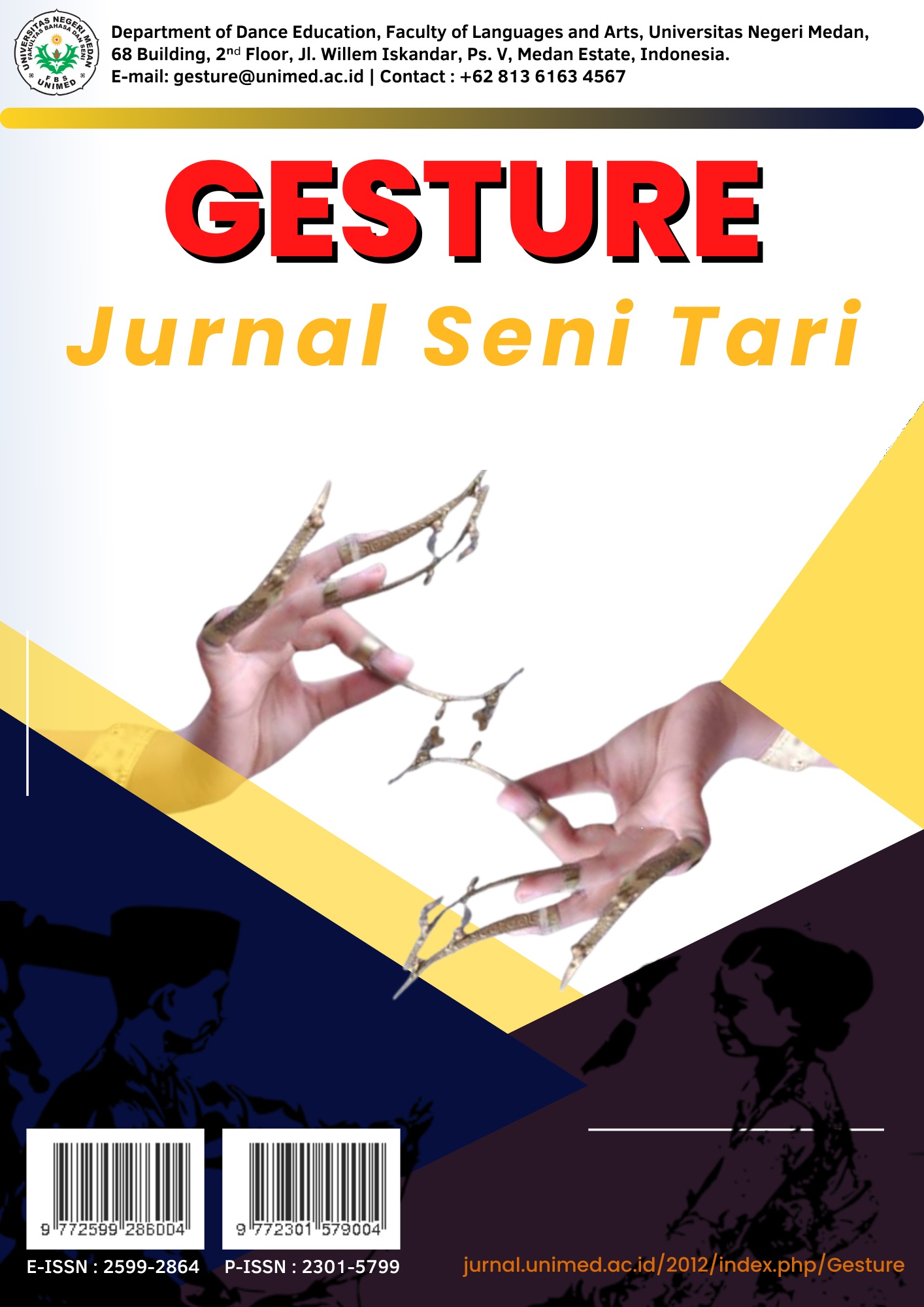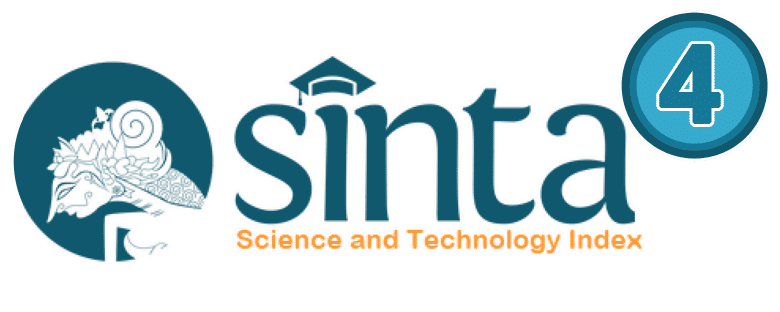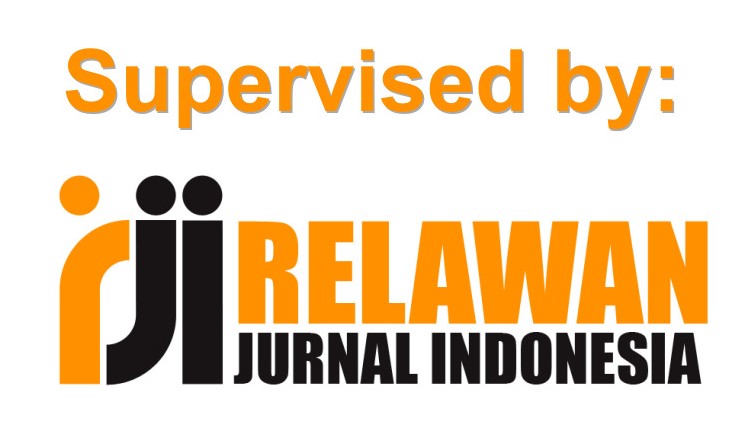Garap Gerak Tari Ronggeng Paser di Kabupaten Paser Kalimantan Timur
DOI:
https://doi.org/10.24114/gjst.v14i2.67781Abstract
The research aims to analyze and describe the form and movement of the Ronggeng Paser dance. Answering the problem of dance forms using the concept of Slamet MD that choreography is known as a dance form that cannot be separated from elements. To answer the problem of motion work using Slamet MD work theory, the concept of solah-ebrah, solah is movement and ebrah is form. The method used is a qualitative research type. Data collection techniques include observation, interviews, and literature studies. The results of the study show that the form concists of elements that are arranged in the Ronggeng Paser dance, including movement, dancers, make-up, costume, floor patterns, dance music and performance venue. And work on the movement by looking at the trajectory, dynamics, volume, tempo that forms the main movement pattern, alternating movements, and variation movements so that a variety of movements are created that have character as an element in the formation of dance that is placed according to the character called estra.References
Aty, M., & Syaifuddin, A. R. (2022). Implementasi Seni Tari Ronggeng Paser Terhadap Perkembangan Sosial Emosional AUD. Journal of Syntax Literate, 7(10), 57-58. https://search.ebscohost.com/login.aspxdirect=true&profile=ehost&scope=site&authtype=crawler&jrnl=25410849&AN=160404079&h=dI4OJ7077SjuJvi9xlFT%2FyKIu4ieImptZS1WPwXZwjpq03ymAbvhESASPwNcKhKHzMH%2FxATm5O71CS723KJ6jQ%3D%3D&crl=c
Hidayah, S. W. N. (2021). Makna Komunikasi Nonverbal Pada Kesenian Tari Ronggeng Paser. ejournal Ilmu Komunikasi, 9(3), 68-78. https://ejournal.ilkom.fisip-unmul.ac.id/site/wp-content/uploads/2021/11/JURNAL%20SRI%20GENAP%20(11-15-21-03-49-07).pdf
Ilam, N. (2017). Tari Ronggeng Paser Sebagai Identitas Masyarakat Suku Paser di Kabupaten Paser Kalimantan Timur. Fakultas Seni Pertunjukan, Institut Seni Indonesia Yogyakarta (ISI) Yogyakarta. http://digilib.isi.ac.id/2626/
Istiani, L, S. (2022). Bentuk dan Fungsi Tari Ronggeng Paser Di Desa Sesulu Gunung Batu Kabupaten Penajam Paser Utara Kalimantan Timur. Jurnal Greget, 21(2), 167. https://doi.org/10.33153/grt.v21i2.4695
Maryono. (2015). Analisa Tari. Surakarta: ISI Press.
MD, Slamet. (2014). Garan Joget: Sebuah Pemikiran Sunarno. Surakarta: Citra Sains LPKBN.
MD, Slamet. (2016). Melihat Tari. Surakarta: Citra Sains
Prihatini, Nanik Sri, dkk. (2007). Ilmu Tari Joged Tradisi Gaya Kasunanan Surakarta. Surakarta: ISI Press.
Prihatini, Nanik Sri. (2011). Dolalak Purworejo Dahulu dan Sekarang. Surakarta: Citra Sains.
Saputra, D. A., & Brotosejati, W. (2020). Garap Gerak Tari Dolalak Lanang Surya Budaya Desa Tlogorejo Kecamatan Purwodadi Kabupaten Purworejo. Jurnal Seni Tari, 9(2), 94-104. https://journal.unnes.ac.id/sju/index.php/jst/article/view/39830/17440
Soedarsono. (1976). Mengenal Tari-Tarian Rakyat di Daerah Yogyakarta. Yogyakarta: Akademi Seni Tari Indonesia.
Soedarsono. (1977). Tari-Tarian Indonesia. Jakarta: Proyek Pengembangan Media Kebudayaan, Direktorat Jendral Kebudayaan, Departemen Pendidikan dan Kebudayaan.
Wahyuni, N. (2017). Analisis Koreografi Tari Ronggeng Paser Karya Dwi Totok Sadianto. Fakultas Seni Pertunjukan, Institut Seni Indonesia Yogyakarta (ISI) Yogyakarta. http://digilib.isi.ac.id/id/eprint/2785
Widowati, K. (2015). Garap Gerak Tari Kijang Kencana Dalam Episode Hilangnya Dewi Sinta Sendratari Ramayana Prambanan Yayasan Rara Jonggrang. Jurnal Greget, 14(1), 32-43. https://jurnal.isi-ska.ac.id/index.php/greget/article/download/1661/1603
Widyastutieningrum, S. R. (2014). Pengantar Koreografi. Surakarta: ISI Press Surakarta dan Pengembangan Ilmu Budaya.
Downloads
Published
Issue
Section
License
Copyright (c) 2025 Andrea Wulandari, Slamet MD, Maharani Lutvinda Dewi

This work is licensed under a Creative Commons Attribution-ShareAlike 4.0 International License.
Authors published with the Gesture: Jurnal Seni Tari agree to the following terms:
- Authors retain copyright and grant the journal the right of first publication with the work simultaneously licensed under a Creative Commons Attribution License (CC BY-SA 4.0) that allows others to share the work with an acknowledgment of the work's authorship and initial publication in this journal.
- Authors are able to enter into separate, additional contractual arrangements for the non-exclusive distribution of the journal's published version of the work (e.g., post it to an institutional repository or publish it in a book), with an acknowledgment of its initial publication in this journal.
- Authors are permitted and encouraged to post their work online (e.g., in institutional repositories or on their website) prior to and during the submission process, as it can lead to productive exchanges, as well as earlier and greater citation of published work. (See The Effect of Open Access)








